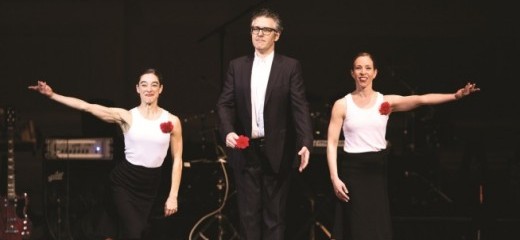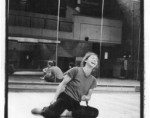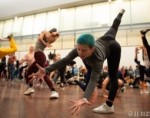
One Radio Host and His Backup Dancers
By Lisa Kraus
We love a good story. Whether told around a campfire or downloaded to an iPod, the feeling’s the same: it’s the ultimate entertainment. And Ira Glass is a modern day master.The popularity he’s built hosting This American Life is obvious looking around the Annenberg on opening night of One Radio Host, Two Dancers. The attendees are “only 20% a dance audience” according to Randy Swartz, Artistic Director of Dance Affiliates, and this audience whoops the moment the lights go down.
Dance is a thornier sell. People think they don’t get it. They’re perplexed not knowing how to find any story in it. Glass has found partners in Monica Bill Barnes and Anna Bass whose work parallels his. Unlike much dance where there isn’t a clear narrative, let alone laughs, Barnes, the choreographer, is all about communicative, easy-to-read (and enjoy) action laced with wit.
The show sets up before our eyes. Glass walks onstage carrying a suitcase with a screw-together lectern in it; Barnes and Bass carry on a miniature proscenium with red curtains, gold borders, and all.
His voice is friendly, as if speaking to us across a kitchen table. He tells us they’re bringing together two forms that don’t necessarily go together. And, conspiratorially, that this is the first ever performance of the experiment. Glass predicts “this thing will be bigger than football”; we can say we were there.
With a few stories told in pitch dark (just like radio, no visual), some accompanied by dance and some movement set to music with no speaking, it’s a well-crafted variety show. It begins with Glass asking how dance shows typically end, and, following a series of stories about love, death and dance, comes through with the suggested glitzy finale.
Barnes and Bass’ dancing is unflagging in its “ta da!” spirit. They bust out in spangly gowns for their first number as Tina Turner belts “Proud Mary.” Subsequent costumes recall Broadway and Astaire: the boutonnieres, the trousers and suspenders, the soft shoe look.
The two dance side by side, facing front like a tap team, with strong stepping on the beat and repeating arm gestures: flings of arms upward and outward, wind-milling hands, fainting poses or split second goofy faces. Some of the material’s recycled from Barnes’ last show at the Annenberg—the disco ball revolving as audience members are featured onstage, the boxing to James Brown. With the exception of their nuanced weight-sharing dance atop a table to a poem about a dying wife’s final days, their movement’s a punchy monotone.
It’s when Glass’ text focusses on the dancers themselves—the nature of their lives, how it is to be them and to do what they do—that the two art forms work together best. Interviewing Bass on tape, he asks what she loves about dancing and she replies “not having to talk.” “An excellent start to an interview,” he quips. But then, as she fills us in on what she thinks about while dancing, particularly the rivalry between Barnes and herself, there’s a surprising disconnect of inner life and outer presentation.
Although the evening’s tone is of bemused wonderment—how can human beings be so weird?—it dives into deep terrain too. Death, impermanence, and grieving are all on the table. But underlying each story is the irony in it; the humor in pathos. Even the late great David Rakoff’s monologue about his own impending death ends with a punch line about taxes and you-know-what.
What Rakoff did, we are told, in his final stage appearance, was to segue into a dance that Barnes coached him in. We see her perform this dance. I had seen Rakoff in this performance on YouTube months back and ached for him as he moved. Through his storytelling he had delivered us to a place where we understood what lay beneath his gestures—his love of this art, his loss of mobility and the impending loss of his life. His decision to end the performance moving and leaving words behind spoke to why we care so much about dance in the first place—its power to say what words can’t.
A couple of days later, still chewing on the performance, I wonder why I can’t simply embrace the show. Why am I conflicted? It’s terrific to see a whole Annenberg audience rise as one at the end of a show featuring dance. But truth to tell, the dance here shines far less brightly than Glass’ own performance. That’s the star, and he would get us to our feet without any backup dancers at all.
It’s terrific too that Glass cares about bringing Barnes’ work to a bigger audience. If her quite accessible work needs this kind of assist, imagine the plight of much of the field. Dance, as a mostly wordless art, has a hard time getting out there and “speaking” to a wider audience. A lot of contemporary dance has moved away from storytelling altogether, asking audiences to “make meaning” out of elements that not everyone is schooled in reading. Without having more motivation to find pleasure in this, it’s just not fun for a lot of folks. But watching bodies move in space, invent new movement languages and reflect the full range of human experience can be exhilarating like nothing else.
People are easily drawn to dance when it’s really virtuosic or showy or dramatic or deliberately funny (as with Barnes). But in the subtler spaces where many artistic adventurers are working today, and where the real ineffability which can give pleasure unique to dance arises, well, mainstream audiences just don’t know how to go there. There’s obviously ambassadorial work to be done. And I guess I hoped this show might go further in doing that. Not that there’s anything wrong with dance that’s clever and showy. But to speak about Dance with a capital D as Glass does is like speaking about Writing with a capital W. Would you have Dave Barry (the humorist) stand in for all Writing? Do all dancers really know every note and step of A Chorus Line as Glass asserts just because Barnes does? It’s a reductive view, handy for storytelling, but perhaps undermining the thing that Glass seems to lean toward—opening his own and others’ eyes to what dance offers. To someone like me who’s been involved with a more nuanced view of it over a long career this is disappointing.
A final note is that WHYY declined to interview Glass in advance of the show. Did they think there’s just not much to be said about dance? Despite whatever quarrels I may have with the show, if anyone could talk about dance in a way that’s smart and entertaining, I still imagine Ira Glass would be your guy.
One Radio Host, Two Dancers, presented by Dance Affiliates and Monica Bill Barnes & Company in association with WHYY, Annenberg Center, April 20 & 21.
By Lisa Kraus
April 25, 2013










